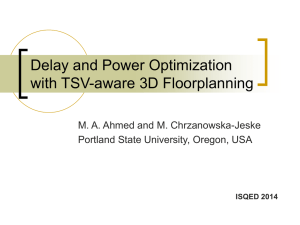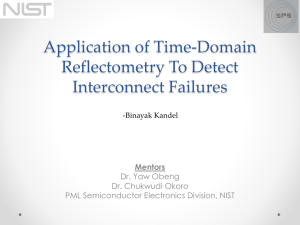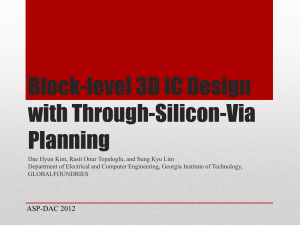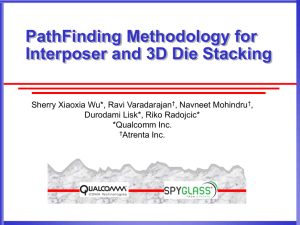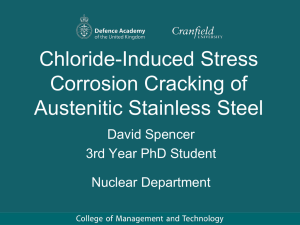Ali_Mohammed Shahid_1
advertisement
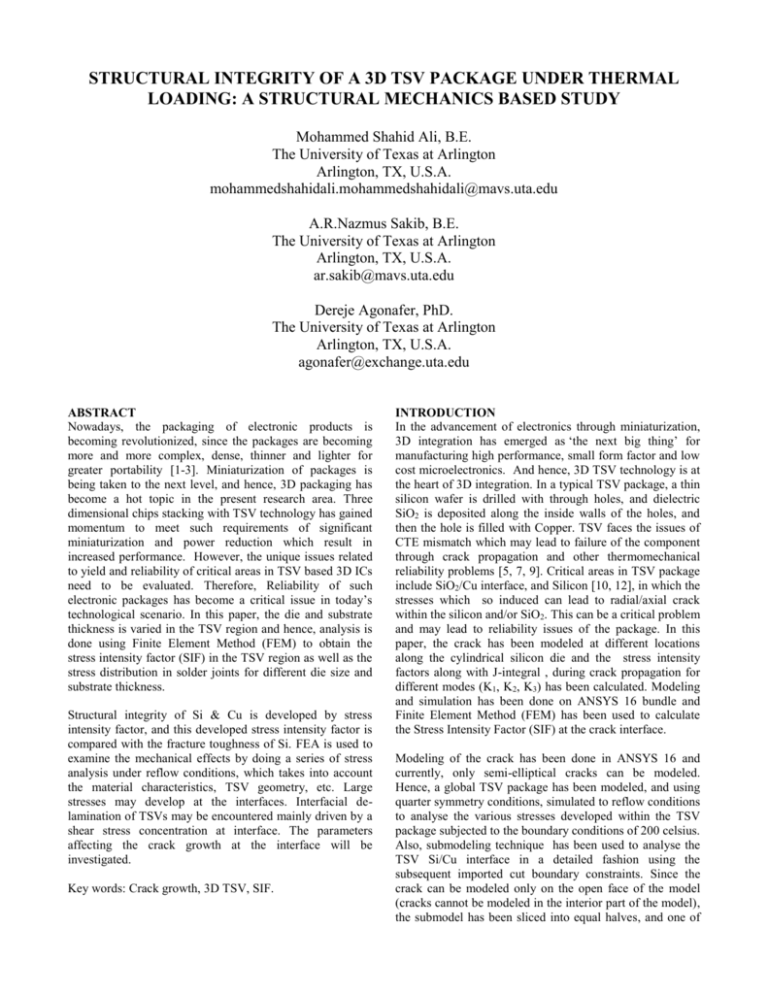
STRUCTURAL INTEGRITY OF A 3D TSV PACKAGE UNDER THERMAL LOADING: A STRUCTURAL MECHANICS BASED STUDY Mohammed Shahid Ali, B.E. The University of Texas at Arlington Arlington, TX, U.S.A. mohammedshahidali.mohammedshahidali@mavs.uta.edu A.R.Nazmus Sakib, B.E. The University of Texas at Arlington Arlington, TX, U.S.A. ar.sakib@mavs.uta.edu Dereje Agonafer, PhD. The University of Texas at Arlington Arlington, TX, U.S.A. agonafer@exchange.uta.edu ABSTRACT Nowadays, the packaging of electronic products is becoming revolutionized, since the packages are becoming more and more complex, dense, thinner and lighter for greater portability [1-3]. Miniaturization of packages is being taken to the next level, and hence, 3D packaging has become a hot topic in the present research area. Three dimensional chips stacking with TSV technology has gained momentum to meet such requirements of significant miniaturization and power reduction which result in increased performance. However, the unique issues related to yield and reliability of critical areas in TSV based 3D ICs need to be evaluated. Therefore, Reliability of such electronic packages has become a critical issue in today’s technological scenario. In this paper, the die and substrate thickness is varied in the TSV region and hence, analysis is done using Finite Element Method (FEM) to obtain the stress intensity factor (SIF) in the TSV region as well as the stress distribution in solder joints for different die size and substrate thickness. Structural integrity of Si & Cu is developed by stress intensity factor, and this developed stress intensity factor is compared with the fracture toughness of Si. FEA is used to examine the mechanical effects by doing a series of stress analysis under reflow conditions, which takes into account the material characteristics, TSV geometry, etc. Large stresses may develop at the interfaces. Interfacial delamination of TSVs may be encountered mainly driven by a shear stress concentration at interface. The parameters affecting the crack growth at the interface will be investigated. Key words: Crack growth, 3D TSV, SIF. INTRODUCTION In the advancement of electronics through miniaturization, 3D integration has emerged as ‘the next big thing’ for manufacturing high performance, small form factor and low cost microelectronics. And hence, 3D TSV technology is at the heart of 3D integration. In a typical TSV package, a thin silicon wafer is drilled with through holes, and dielectric SiO2 is deposited along the inside walls of the holes, and then the hole is filled with Copper. TSV faces the issues of CTE mismatch which may lead to failure of the component through crack propagation and other thermomechanical reliability problems [5, 7, 9]. Critical areas in TSV package include SiO2/Cu interface, and Silicon [10, 12], in which the stresses which so induced can lead to radial/axial crack within the silicon and/or SiO2. This can be a critical problem and may lead to reliability issues of the package. In this paper, the crack has been modeled at different locations along the cylindrical silicon die and the stress intensity factors along with J-integral , during crack propagation for different modes (K1, K2, K3) has been calculated. Modeling and simulation has been done on ANSYS 16 bundle and Finite Element Method (FEM) has been used to calculate the Stress Intensity Factor (SIF) at the crack interface. Modeling of the crack has been done in ANSYS 16 and currently, only semi-elliptical cracks can be modeled. Hence, a global TSV package has been modeled, and using quarter symmetry conditions, simulated to reflow conditions to analyse the various stresses developed within the TSV package subjected to the boundary conditions of 200 celsius. Also, submodeling technique has been used to analyse the TSV Si/Cu interface in a detailed fashion using the subsequent imported cut boundary constraints. Since the crack can be modeled only on the open face of the model (cracks cannot be modeled in the interior part of the model), the submodel has been sliced into equal halves, and one of the halves from the model is used so as to model the crack in the cylindrical silicon interposer (with imported cut boundary conditions). The behaviour of Stress intensity factor and J-integral has also been studied by varying the die and substrate thickness, and the SIF is compared with the fracture toughness of silicon. MODEL DESCRIPTION Global and Submodels Crack propagation analysis has been done on a 2 die 3-D flip chip package with TSV and the response of the package when attaching the chip to the substrate is studied. The diameter of the TSV is 10μm which includes the 0.5μm thick dielectric around it. Approximately 1.5% of the chip real estate (CRE) is occupied by the TSV’s and in order that we don’t inadvertently affect the silicon efficiency, the TSV area is limited to <4%. A novel compact modeling technique as demonstrated by Mirza et al.[8] and Chirag et al.[11], has been done so that a reasonable computational time is maintained. Simulation is performed in 3 steps – a compact global model is formulated and solved; results from the compact global model are used as boundary conditions in the sub-model 1 which is usually the far corner region of the package (critical region) with detailed features such as actual μ-bump interconnects and the TSVs. The submodel 2 is a half model of the submodel 1 on which the imported boundary conditions are applied and the crack is formulated. As a part of symmetry boundary conditions, normal displacement to symmetric faces are constrained and center node of bottom is fixed to prevent rigid body motions. All materials in this work except solder (SAC305) and copper (TSVs and BEoL) metal are modeled using linear elastic material properties taken from Pavan et al. [6]. Solder is modeled as rate-dependent viscoplastic material using Anand’s viscoplastic model, which takes into consideration both creep and plastic deformations to represent the secondary creep of solder. Anand's viscoplastic constitutive law has been used to describe inelastic behavior of lead-free solder. Anand's law accounts for solder's strain-rate and temperature sensitivity through its nine material constants A, Q, ξ, m, n, h , a, s , ŝ which are determined by curve-fitting the experimental data. 0 Table 1. Anand’s Constants for SAC305 S. No. Anand’s Units Constant 1 MPa s 0 2 3 Q/R A 4 5 6 ξ m h sec Dimensionless Dimensionless MPa 7 8 9 ŝ n a MPa Dimensionless Dimensionless 0 1/K -1 Value 1.3 9000 500 7.1 0.3 5900 39.5 0.03 1.5 Table 2. Anand’s Constant for Effective Block in the Compact Model S. No. Anand’s Units Value Constant 1 MPa 0.15 s 0 2 3 Q/R A 4 5 6 ξ M h sec Dimensionless Dimensionless MPa 7 8 9 Ŝ N A MPa Dimensionless Dimensionless 0 1/K -1 9000 500 7.1 0.3 5900 3 0.03 1.5 In this technique, the crack propagation is intricately explained along the different locations equally spaced along the cylindrical silicon die interposer along which the TSV and copper passes. The critical areas in TSV are found to be silicon and silicon dioxide interface, and hence, crack has been succesfully modeled along the silicon die/Cu interface which is a prominent region along where the critical stresses are acting through which crack may develop. CRACK FORMULATION METHODOLOGY 0 Top Die Substrate Figure 1. Global Model with Exploded Submodel 1 Figure 2. Crack formulation in the Silicon die at the mid section of Submodel 2. Since the total edge length of the TSV is 95μm, each simulation for the crack has been done with 10 equally spaced divisions along the TSV length in the submodel 2, with each division equal to 9.5μm. The loading was the reflow condition for the 3D TSV package when it is attached to substrate from 200°C to room temperature (for Pb-free SAC305 Alloy). The stress intensity factors (K1, K2, K3) and J-Integral for different modes for different crack locations have been calculated and the parameters affecting the results have been discussed subsequently with the aid of plots and stress distribution. Analysis had been done to verify as to which area of the TSV is more susceptible to Mode 1, Mode 2 and Mode 3 cracking. Based on linear elastic fracture mechanics, the critical condition to avoid the radial crack is to satisfy K < Kc, where Kc is the fracture toughness of silicon. more prevalent in the top portion of the Silicon/TSV interface (Figure 5). Similarly, in Figure 6, the plot between K3 & crack location infers that the top & bottom portions of the TSVs are more susceptible to Mode 3 fracture since K3 is higher in those regions & minimum in the middle region. 20000 10000 K1(Pa.m1/2) In order to model and formulate radial horizontal crack for the TSV package, ANSYS 16 bundle has been used. Also, cracks can be modeled in ANSYS only with a tetrahedron mesh profile, and as of yet, only semi-elliptical cracks can be modeled on the ‘exterior’ surface of the model. Hence, the global model was first subjected to reflow conditions and solved, after which the submodel 1 was cut into equal halves, and simulated to same reflow conditions as a whole comprehensive model. The submodel 2, in which the crack was modeled, consists only of a single symmetrical half of submodel 1, which was again subjected to reflow conditions, with imported cut boundary constraints applied systematically from the model (Submodel1). 0 4.6 -10000 4.8 5 (Bottom) 5.2 5.4 5.6 5.8 (Top) (Mid) -20000 -30000 -40000 Crack Location (Global Z-Axis) -50000 Figure 4. Silicon die/Cu stress distribution with K1 plot. 60000 50000 40000 K2(Pa.m1/2) 30000 20000 10000 0 -10000 4.6 -20000 4.8 5 5.2 5.4 (Mid) (Bottom) 5.6 5.8 (Top) Crack Location (Global Z-Axis) Figure 5. K2/Crack location plot. 90000 80000 70000 60000 K3(Pa.m1/2) Figure 3. Deformed Global Model. 50000 Simulation and Validation From the stress distribution data acquired by simulating the reflow conditions, it has been analysed that the normal stress (in Z direction in our case) is positive across the middle area of the silicon/Copper interface. This has also been validated through the plot between Stress intensity factor (K1) and crack location as shown in Figure 4. The trend in the plot infers that the middle area of TSV is susceptible to Mode 1 fracture. The value of K1 is positive across the middle region. The Mode 2 crack propagation is 40000 30000 20000 10000 0 4.5 (Bottom) 4.8 5.1 (Mid) 5.4 (Top) 5.7 Crack Location (Global Z-Axis) Figure 6. K3/Crack location plot 6 Variation of Die and Substrate Thickness The crack behaviour in the TSV region has also been studied by incorporating variation in the die and substrate thickness to analyse whether any significant change is caused in the strain energy release rate with respect to die and substrate thickness variation. It is to be noted that in this case, the crack propagation was analysed only in the middle section of the TSV region and the substrate thickness was varied from 0.2mm to 1mm, with increments of 0.2mm. The change in the substrate thickness has been done in all the models (global model, submodel 1 and submodel 2), so as to maintain consistency in the imported boundary conditions. Effect of Die and Substrate Thickness Variation on Solder Joints Since the solders also play an important role in the reliability of TSV packages, study has been done as to whether the change in the die and substrate thickness induce any appreciable amount of stresses (Von Mises) in solder joints. From simulation analysis of variation of substrate thickness, the equivalent stresses in top and bottom solders when the substrate thickness was 0.2mm was found to have a maximum value of 33MPa. When the substrate thickness was increased to 0.8mm, the stresses induced in solders had a minute increase of 0.3MPa. The J-integral does seem to have a relationship with respect to substrate thickness which can affect the crack formation. Initially, as the thickness of substrate is increased, the Jintegral tends to follow a steep downward curve which signifies a decrease in crack driving force. As the substrate thickness is further increased, the J-integral’s takes on a progressive positive slope, signifying a gradual increase in crack driving force (Figure 7). When the die thickness was increased from 0.1mm to 0.5mm, the equivalent stress in the bottom solder joint increased by 0.2MPa, resulting in a new value of about 33.2MPa. This signifies that the solder joint stresses doesn’t get much affected with the variation of die thickness. The top die variation has been done by varying the thickness in equal increments of 0.1mm. The J-Integral decreases upto a certain limit with respect to die thickness, and eventually starts to increase with the increase in top die thickness (Figure 8). J-Integral (J/m2) 3.00E-02 2.50E-02 2.00E-02 1.50E-02 1.00E-02 5.00E-03 Figure 9. Equivalent stress distribution in solder joints with 0.2mm substrate thickness in Submodel 1. 0.00E+00 -5.00E-03 0.2 0.4 0.6 0.8 1 1.2 Substrate Thickness (mm) J Integral (J/m2) Figure 7. J-Integral vs Substrate Thickness Plot 1.80E-03 1.60E-03 1.40E-03 1.20E-03 1.00E-03 8.00E-04 6.00E-04 4.00E-04 2.00E-04 0.00E+00 0.2 0.3 0.4 0.5 0.6 Die Thickness (mm) Figure 8. J-Integral vs Die Thickness Plot Figure 10. Half sectional view showing the stress distribution in top and bottom solders with 0.1mm die thickness in Submodel 1 . Table 3. Maximum Equivalent stress in solder joints at different die and substrate thickness. RESULTS AND DISCUSSION Figure 11. 3D TSV Wafer breakdown by Application [4]. Figure 12. Stress intensity factor distribution K2 at crack location in Submodel 2. In dealing with thermo-mechanical during the attachment of chip to conditions, tensile hoop stress and due to CTE mismatch causing reliability issues in TSV the substrate in reflow axial stress is generated stress concentration to increase in the interface between Cu/SiO2, the dielectric and TSV. Failure of silicon occurs along <111> cleavage planes. From empirical data, the fracture toughness of Silicon is 0.83 to 0.95 along <111> plane, 0.91 along <100> plane, 0.94 along <110> plane, 0.94 for polycrystalline silicon. From our analysis, it has been found that the fracture toughness of silicon near the crack susceptible region is well below the limits. Although, there is a significant probability that the mismatch may cause the crack to propagate in the critical areas where the magnitudes of K1, K2, K3 are higher. From the trend acquired in the plots discussed above, it is possible to predict and track the behavior and methodology of crack propagation, which, in our case, was the study of silicon die surrounding the TSV region subjected to thermo mechanical stresses. Since this is a preliminary study where our focus has been mainly analyzing radial horizontal cracking along the length of silicon die, further work can be done in this area to evolve and have a breakthrough in TSV technology, where improvised software bundles help us to simulate different types of cracks within the silicon and/or TSV/Cu interface. (This might improvise and be updated in the future versions of ANSYS). CONCLUSION To conclude, radial crack propagation along the length of silicon die through which TSV passes has been successfully studied, and crack has been successfully modeled in a half cut submodel and simulation has been done by importing cut boundary conditions from global model and submodel 1 to highlight the areas in silicon die/Cu/TSV interface where the magnitudes of stress intensity factors are higher. This has been validated with the aid of various plots discussed in this paper which substantiate the results. The values have been compared with the fracture toughness of silicon. The variation of die and substrate thickness has also been successfully leveraged to investigate its effect on stress distribution in solder joints. REFERENCES [1] Ramm P, Wolf, MJ, Klumpp A, et al, “Through silicon via technology – processes and reliability for wafer-level 3D system integration”, 58th Electronic Components and Technology Conference, Orlando, FL, pp.841-846, 2008. [2] Khan N, Rao S, Lim S, et al, “Development of 3D silicon module with TSV for system in packaging”, 58th Electronic Components and Technology Conference, Orlando, FL, pp.550-555, 2008. [3] Lau JH. Overview and outlook of through-silicon via (TSV) and 3D integrations. Microelectron Int 2011; 28:8–22. [4] 3DIC & 2.5D TSV Interconnect for Advanced for Advanced Packaging 2014 Business Update report, Yole Development, July 2014. [5] E. J. Cheng, Y.L. Shen, “Thermal expansion behavior of through-silicon-via structures in threedimensional microelectronic packaging”, 2011. [6] P. Rajmane, F. Mirza, et al, “Chip Package Interaction to Analyze the Mechanical Integrity of a 3-D TSV Package”, 2015. [7] Selvanayagam, CS; Lau, JH; Zhang, XW, et al., “Nonlinear thermal stress/strain analyses of copper filled TSV (through silicon via) and their flip-chip microbumps”, 58th Electronic Components and Technology Conference, Orlando, FL, pp.1073 1081, 2008. [8] F. Mirza, “Compact Modeling Methodology Development for Thermo-Mechanical Assessment in High-End Mobile Applications” - Planar 3D TSV Packages, Arlington, TX, 2014. [9] Karmarkar AP, Xu X, Moroz V. Performance and reliability analysis of 2D integration structures employing through silicon via (TSV). In: Proc IEEE 47. Annual Int Reliab Phys Symp; 2009. p. 682–7. [10] Reiske R, Landgraf R and Wolter KJ, “Novel method for crystal defect analysis of laser drilled TSVs”, 59th Electronic Components and Technology Conference, San Diego, CA, pp.11391146, 2009. [11] C. Shah, F. Mirza and C. S. Premachandran, "Chip Package Interaction(CPI) Risk Assessment On 28nm Back End Of Line(BEOL) Stack Of A Large I/O Chip Using Compact 3D FEA Modeling," in EPTC, Singapore, 2013. [12] Kuo TY, Chang SM, Shih YC, et. al, “Reliability tests for a three dimensional chip stacking structure with through silicon via connections and low cost”, 58th Electronic Components and Technology Conference, Orlando, FL, 2008.

